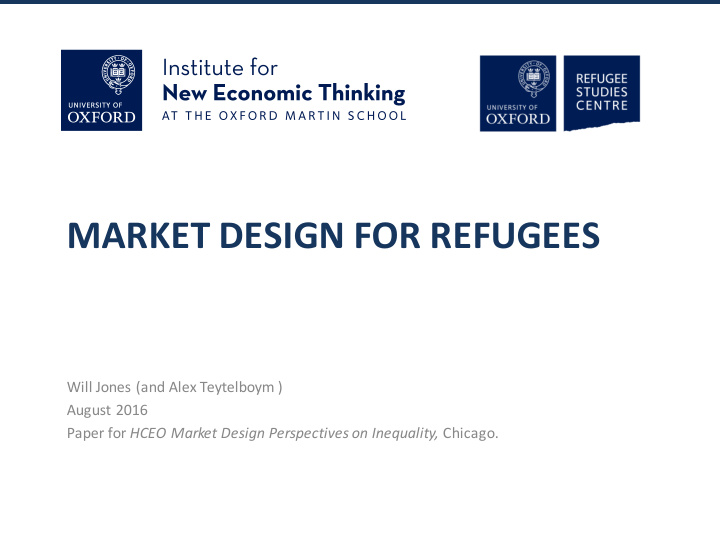



MARKET DESIGN FOR REFUGEES Will Jones (and Alex Teytelboym ) August 2016 Paper for HCEO Market Design Perspectives on Inequality, Chicago.
The Global Refugee Crisis • 65.3m displaced persons worldwide, highest recorded number ever • 16.1m refugees under UNHCR mandate • 54% in ‘protracted’ situations (average: 17 years) • Most refugees from Syria: 4.9 million, Afghanistan: 2.7 million and Somalia: 1.1 million • 3.2 million asylum seekers • Record numbers trying to reach Europe
The International Refugee Regime 1) Asylum : - “ states ’ obligations to protect refugees on their territory ” - Strongly institutionalized - Predominantly subject to law (legitimacy and reciprocity) 2) Burden-sharing : - “ states ’ obligations to contribute to the protection of refugees on the territory of other states ” (e.g. financial/resettlement) - Weakly institutionalized - Predominantly subject to politics (interests and power) After protection: ‘three durable solutions’ – resettlement, repatriation, and local integration
Two types of inequality:
The Problem After how many, who goes where? • Political deadlock in Europe • Unfairness and danger • Refugees have little to no agency
The Idea Designing two-sided matching markets for refugee resettlement: • Internationally (EU, etc – Hillel’s paper) • Locally (Alex, David, and Scot) – Britain: one central scheme, voluntary participation, very granular – Canada: different statuses (public, private, blended) – USA: matched to agencies, then to areas
“The EU and some member states have underestimated and failed to mitigate the risks of unmanaged migration” Robert Fico Slovakian Prime Minister
Integration
Not all states prioritise in the same way
“asylum seekers must understand that they cannot choose the states where they are seeking protection” Thomas de Maizière, German Minister of the Interior
Refugees’ preferences matter
States’ preferences matter Good health Children Family ties Threat to public order Refugee status Vulnerability Education International protection Language Family units Germany France Hungary Luxembourg Poland Portugal Romania Slovakia Slovenia UK Source: EASO Fact-finding report on intra-EU relocation Activities from Malta (EUREMA I&II, 2012)
Where would refugees fare well?
Refugees’ preferences? • Family reunification • Safety • Employment opportunities • Welcoming local areas • Educational, language and welfare support
States’ priorities? • (Perception of) control • Ensuring buy-in from local areas • Ability to provide social services • Integration • National security • Value for money
How can we satisfy both sides?
What is two-sided matching? An allocation of resources where both parties to the transaction need to agree to the match in order for a match to take place.
e.g. school choice , kidney exchange, hospital residency (no money involved!)
Properties of matching outcomes • Maximal – match as many refugees/refugee families as possible • Stable (“fair”) – no priorities are violated • Efficient - no one can be made better off without making someone worse off • Safe - report your actual preferences; can’t game the system
The IN Refugee Match: the basics Match refugees families • across states Determine quotas first • Deciding what criteria to • include: ethical and political choice Elicit priorities and • capacities of regions and the preferences of refugees Centralised process, one • application (e.g. via “EU embassy”, CEAS, EASO)
The Refugee Match: the concerns • What if all refugees want the same thing? • What if all states want the same thing?
The European Context: benefits • Successful integration • Managing irregular flows • Limiting costs to states • Persuading states to participate in burden-sharing • Giving refugees agency and states control
But who goes where exactly ?
Do refugees go to “good” local areas?
Initial allocations really matter
Local refugee match • Match between refugees (once status is determined) and local areas • Can work for resettlement, relocation and dispersal • Local areas have capacities across a variety of services: housing, schools, hospital, language support, adult education etc. • Refugee families require different bundles of services
(British) local refugee match • Match between refugees and local areas • Refugee families require different services and have different needs and aspirations • Local areas have capacities across a variety of services : housing, schools, hospital, language support, adult education etc. • British Syrian Vulnerable Persons Resettlement Scheme : 20,000 refugees to be resettled into 100 local authorities by end of Parliament (!)
British local refugee match • September 2015: resettle 20,000 Syrians by end of Parliament (!) • Syrian Vulnerable Person Resettlement • (VPR) Programme • Dozens of LAs have signed up • “First 12 months of a refugee’s resettlement costs, excluding economic integration are fully funded by central government using the overseas aid budget”
British local refugee match • Integrate databases on current capacities (esp. housing) from LAs • Create a database of LA characteristics • Gentle questionnaire to elicit preferences of refugees • Different algorithms to achieve various ends • Benefits: terrific value for money, robust, systematic, collects data for future responses
Further questions • Dynamic matching • Allocating into different ‘solutions’ • ‘Common-but-differentiated responsibility’ • ‘Clustering’ and communities • Secondary movement Most generally: integrating with the migration studies literature.
www.Refugees-Say.com
Recommend
More recommend